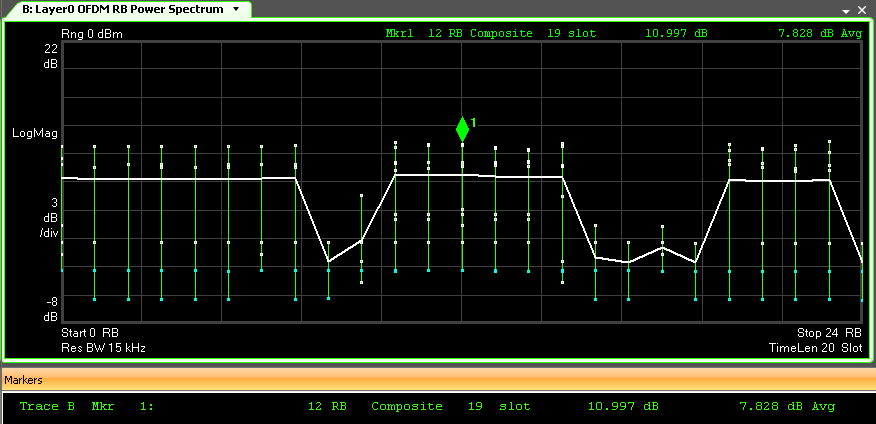RB Power Spectrum (LTE-Advanced)
shows the resource block power spectrum for the demodulated data specified by Measurement Interval and Measurement Offset. For trace formats that show magnitude (Linear Mag or Log Mag (dB)), multiple power values are plotted above each RB Resource Block index on the x-axis. Each point represents the power of a particular slot in the . The distance away from the x-axis expresses the power.
The trace is different from the other traces in that
- channel frequency response equalization has not been applied
- non-alloc resources are included whether or not Non-alloc has been selected on the tab of the LTE-Advanced Demod Properties dialog box
Resource block numbering starts from 0 and increases with frequency.
The In-band Emissions trace can be used to make in-band emissions measurements for uplink signals.
The data in this trace is generated from the 2D IQ Meas (frequency x time) data grouped into resource blocks (12 subcarriers x 1 slot). The powers of the resource elements are summed for each resource block, and the resulting resource block powers are plotted along the frequency axis. To view the resource block powers plotted with respect to time, use the RB Power Time trace.
For downlink signals, PDSCH Physical Downlink Shared Channel IQ data used in calculating this trace comes from the layer chosen when selecting this trace. Other LTE Long Term Evolution channels/signals are included in Layer traces for convenience. For more details, see the Layer Traces and Resource Element Distribution topic.
For uplink signals, the IQ data comes directly from the OFDM Orthogonal Frequency Division Multiplexing: OFDM employs multiple overlapping radio frequency carriers, each operating at a carefully chosen frequency that is Orthogonal to the others, to produce a transmission scheme that supports higher bit rates due to parallel channel operation. OFDM is an alternative tranmission scheme to DSSS and FHSS. symbol FFT Fast Fourier Transform: A mathematical operation performed on a time-domain signal to yield the individual spectral components that constitute the signal. See Spectrum., except for PUSCH Physical Uplink Shared Channel. PUSCH subcarriers are despread before being used in calculations.
The marker on the trace shown below

indicates that
- the marker is on resource block 12 (RB 0 is the farthest left RB in frequency)
- the power in the resource block is a composite of multiple channels/signals (see Composite Include)
- the marker is on slot 19
- the resource block has an RMS power of 10.997 dB (for downlink, 0 dB is determined by C-RS Power Boost; and for uplink, 0 dB is determined by the power setting of the channel selected for Sync Type)
- the average power over all slots for RB 12 is 7.828 dB
Points on the trace are colored to represent which channel/signal they contain. When a resource block contains more than just one channel/signal (which is often the case unless some channels are turned off in Composite Include), the point will be colored white and a marker on the point will be labeled "Composite."
You can disable the average line for this trace by clearing the check box.
When the average line is disabled, the marker will not display the average value for the current marker location.
See Also
